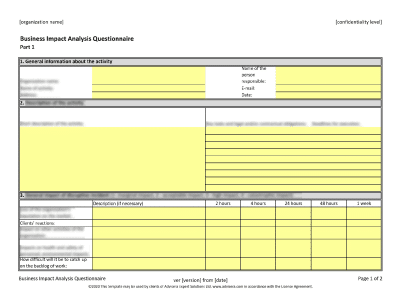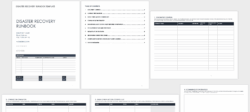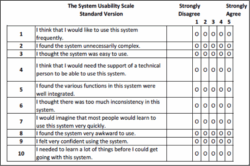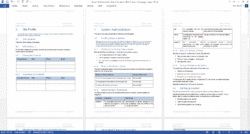Ever wondered how your business would fare if a critical system failed, a natural disaster struck, or a key supplier went out of business? It’s not a pleasant thought, but it’s a crucial one for any resilient organization. This is where a Business Impact Analysis (BIA) comes into play, helping you understand the potential effects of disruptions on your operations. And to conduct a truly effective BIA, especially in a complex organization, you need a structured approach. That’s precisely what a well-designed business impact analysis survey template offers.

Think of it as your roadmap to identifying critical functions, assessing potential damages, and prioritizing recovery efforts. Without a standardized template, collecting consistent and actionable data across different departments and stakeholders can feel like herding cats. A template ensures everyone provides the necessary information in a uniform way, making the analysis phase much smoother and the resulting business continuity plan far more robust. It’s about being proactive, not reactive, when the unexpected inevitably happens.
Why a Business Impact Analysis Survey Template is Your Strategic Compass
A BIA is fundamentally about understanding the vulnerability of your organization to various disruptions. It’s not just about identifying what *could* go wrong, but also understanding the cascading effects and the true cost of those disruptions. A robust BIA helps you determine your Recovery Time Objectives (RTOs) – how quickly you need a function back online – and your Recovery Point Objectives (RPOs) – how much data loss you can tolerate. These metrics are the bedrock of any effective disaster recovery or business continuity strategy.
Using a survey template brings much-needed standardization to this critical process. Imagine trying to compare data from different departments if each one used a unique method for reporting impacts or recovery times. It would be a nightmare! A template ensures that every department, every process owner, and every key stakeholder provides information in a consistent format. This uniformity is vital for accurate aggregation, comparison, and ultimately, for making informed decisions about resource allocation for recovery efforts.
Key Elements to Include in Your BIA Survey
To ensure your survey is comprehensive and captures all necessary information, consider these essential components:
- Department and Process Identification: Clearly define the area or process being assessed. This seems obvious, but specific naming helps avoid confusion.
- Impact Areas: Quantify the potential financial, operational, reputational, and regulatory impacts of a disruption. Think about lost revenue, compliance fines, customer churn, and damage to brand image.
- Interdependencies: Identify which other departments, systems, or external suppliers this process relies on, and which ones rely on it. This uncovers hidden risks.
- Recovery Time Objectives (RTOs): For each critical function, determine the maximum tolerable downtime before unacceptable consequences occur.
- Recovery Point Objectives (RPOs): Establish the maximum amount of data your organization can afford to lose following an incident.
- Resource Requirements: Detail the people, technology, facilities, and external services needed to recover and resume operations.
- Existing Mitigation Strategies: Document any current safeguards or controls already in place that help reduce the likelihood or impact of a disruption.
By including these key elements, your survey becomes a powerful data collection tool. It prompts respondents to think systematically about their processes and potential vulnerabilities, moving beyond just guesswork to provide concrete data. This structured approach helps ensure no critical stone is left unturned.
The data collected through such a structured survey isn’t just a compliance checkbox exercise; it’s the intelligence that fuels your business continuity and disaster recovery plans. It allows you to prioritize which functions absolutely must be restored first, allocate resources effectively, and develop targeted strategies to minimize downtime and financial loss. It moves your organization from a state of hopeful resilience to one of planned, strategic resilience.
Crafting and Implementing Your Effective BIA Survey
Creating an effective BIA survey template isn’t just about listing questions; it’s about designing a tool that encourages accurate and thorough responses. Begin by clearly defining the scope of your BIA. Are you assessing the entire organization, or a specific department or critical process? Tailor your questions to be clear, concise, and unambiguous. Avoid jargon where possible, or provide definitions. Involve key stakeholders in the survey design process to ensure it captures all relevant perspectives and that the language resonates with the people who will be completing it.
Once your template is ready, the implementation phase is crucial. Effective communication is paramount. Clearly explain the purpose of the BIA, why each person’s input is vital, and how the collected data will be used to enhance the organization’s resilience. Provide clear instructions on how to complete and submit the survey. Consider holding informational sessions or providing a point of contact for questions. Encouraging active participation and emphasizing the collaborative nature of building a stronger organization will yield much better results than simply sending out a generic email.
After collection, the real work of analysis begins. This involves compiling the data, identifying trends, pinpointing critical dependencies, and highlighting potential single points of failure. Look for areas where RTOs are tight, but recovery resources are scarce. Identify processes with high impacts but low existing mitigation. This analytical phase transforms raw data into actionable insights, allowing your organization to visualize its risk landscape and prioritize where to invest in continuity measures. It might involve cross-referencing information from different departments to ensure consistency and identify discrepancies that need further investigation.
Remember that a BIA is not a one-time event; it’s an ongoing process. Your business evolves, processes change, and new technologies emerge. Therefore, your business impact analysis survey template should also be a living document. Regularly review and update the template based on feedback, lessons learned from actual incidents (if any), and changes within the organization. This iterative approach ensures your BIA remains relevant and effective, continually strengthening your organization’s ability to withstand and recover from disruptions, securing its future even in uncertain times.
Ultimately, having a systematic way to understand your vulnerabilities and critical functions is not just good practice; it’s essential for survival and growth. Leveraging a structured survey template empowers your organization to move beyond guesswork, providing the clear, actionable data needed to build robust business continuity and disaster recovery plans. It ensures that when challenges arise, you are equipped not just to react, but to recover strategically and swiftly, minimizing losses and protecting your reputation.
By investing time in developing and regularly updating your assessment tools, you are proactively fortifying your business against the unforeseen. This commitment to understanding potential impacts and preparing for them transforms uncertainty into resilience, allowing your organization to navigate disruptions with confidence and emerge stronger on the other side. It’s a foundational step towards long-term stability and sustained operational excellence.



